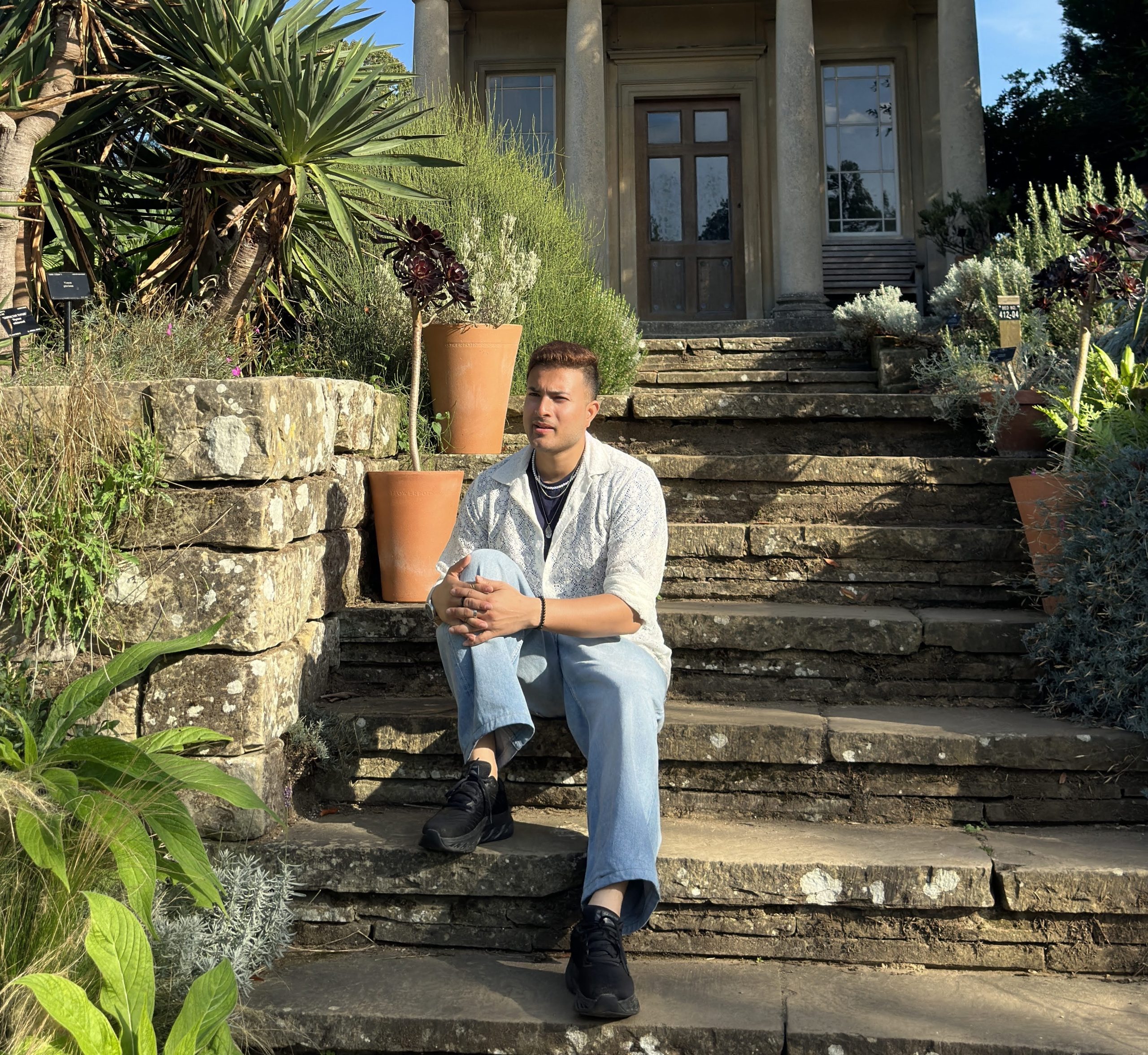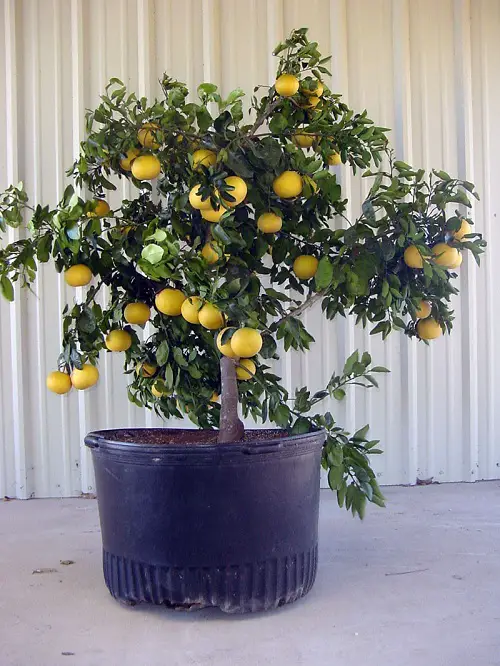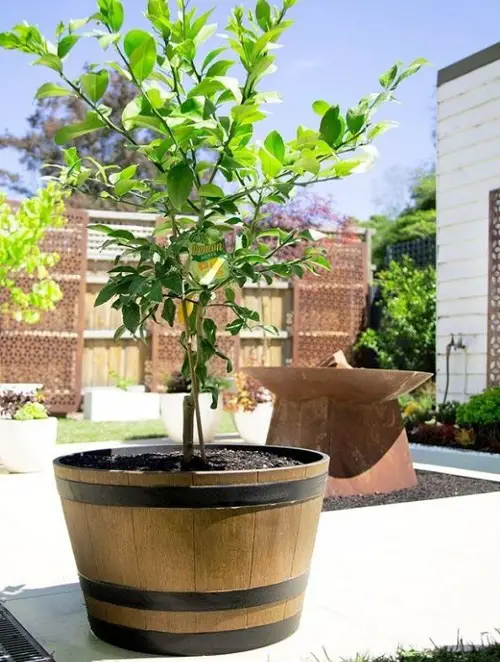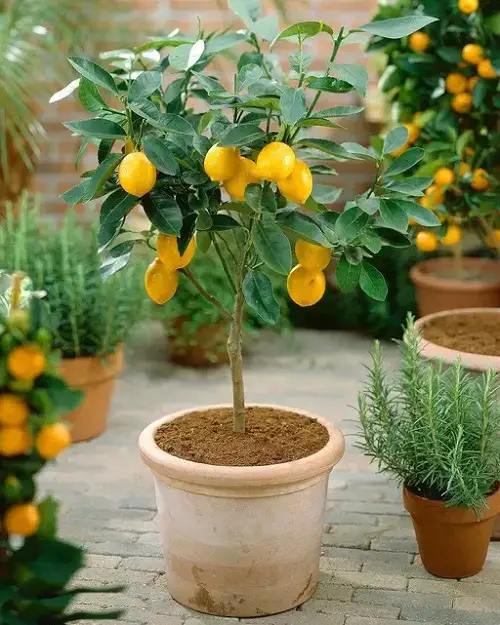If you are a citrus fan but live in a cold climate or have a small balcony or patio, then go for these dwarf Lemon Tree Varieties for Containers!
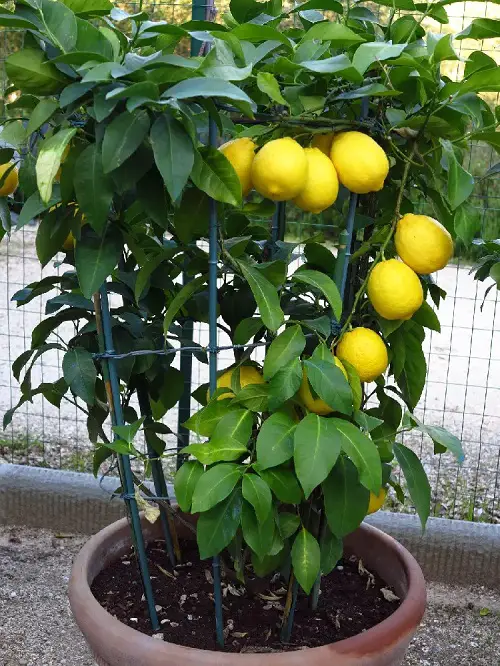
Growing Lemon Tree in Containers is a bright and zesty way to bring a slice of the Mediterranean to your balcony or patio; if you don’t live in a warm climate, this is even better, as you can move your planters indoors in winter.
Best Lemon Tree Varieties for Containers 🍋
1. Meyer Lemon
Botanical Name: Citrus x meyeri
The Meyer Lemon is the poster child of all the container lemon trees. It’s a sweet hybrid, less tart than traditional lemons, and has a lovely floral aroma. This variety is compact and loves living in a pot.
Why Should You Grow It?
This plant stays compact, growing upto 4-6 feet in height. The biggest advantage is it’s more cold-hardy than many other lemon varieties and can tolerate mild frost and freezing temperatures down to 20 F (-6 C).
2. Ponderosa Lemon
Botanical Name: Citrus limon ‘Ponderosa’
Ponderosa lemons are like the bodybuilders of the lemon world – big, bold, and showy. The tree stays small enough for pots but produces large, juicy lemons.
Why Should You Grow It?
It stands out for its exceptionally large fruits and a rich, tart flavor that surpasses many other lemon varieties. Ideal for those looking to grow lemons for cooking and baking purposes.
Use Lemon Juice for Orchids & These 7 Miracles will Happen
3. Eureka Lemon
Botanical Name: Citrus limon ‘Eureka’
The Eureka lemon is your classic, supermarket-style lemon. It’s a prolific producer, even when confined to a container. This plant loves full sun but doesn’t mind a bit of shade.
Why Should You Grow It?
It is known for its ability to produce fruit almost all year round, making it an excellent choice for continuous harvesting.
4. Dwarf Lisbon Lemon
Botanical Name: Citrus limon ‘Lisbon’
A tough tree that can handle some neglect. It produces classic tart lemons and has a strong citrus fragrance. The plant is pretty low-maintenance.
Why Should You Grow It?
It is particularly cold hardy – tolerating temperatures as low as 20 to 25 degrees Fahrenheit (-7 to -3.9 degrees Celsius), making it suitable for cooler climates where other citrus might struggle.
14 Best Scented Flowers That Smell Like Lemon & Orange
5. Dwarf Genoa Lemon
Botanical Name: Citrus limon ‘Genoa’
This Italian variety is known for its sweet and juicy lemons. It’s perfect for those wanting a “lemonade stand” on their balcony.
Why Should You Grow It?
It is celebrated for resisting common citrus diseases, making it a robust and low-maintenance choice for gardeners.
6. Variegated Pink Lemon
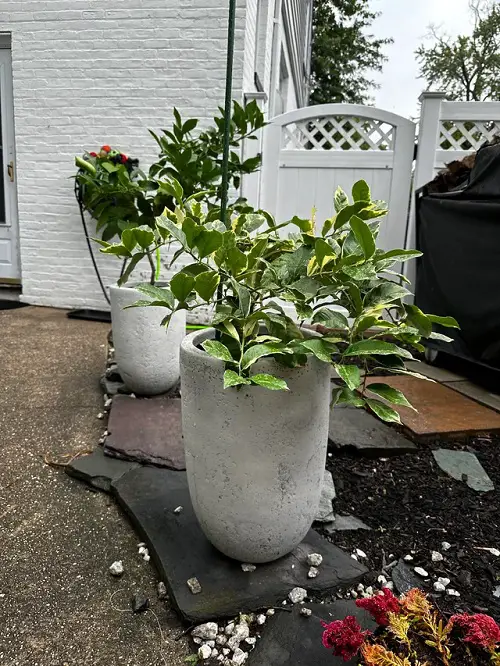
Botanical Name: Citrus x limon ‘Variegated Pink’
This variety is for those who like a twist. It has green and yellow striped leaves and pink flesh. It’s a real show-off in a container. Prefers full sun but can manage in partial shade.
Why Should You Grow It?
This variety is not just about the fruit; it’s also about the beauty it adds to your garden. It boasts striking green and yellow-striped leaves with a blush-pink flesh inside the fruit.
One Secret to Grow Unlimited Lemons in a Cup
7. Kagzi Lemon
Botanical Name: Citrus aurantifolia
This is one of the most productive lemon varieties from the Indian subcontinent, known for its thin skin and juicy content. It can be trained to maintain a height of around 4-5 feet.
Why Should You Grow It?
It is renowned for its high juice content, making it an excellent choice for lemonade and culinary uses.
8. Shatkora

Botanical Name: Citrus macroptera
A unique variety predominantly found in the Bengal region of India and Bangladesh, it is highly aromatic and prized for its fragrance. It’s a relatively small size, making it suitable for container growing.
Why Should You Grow It?
It is used extensively in Southeast Asian cuisine, offering a unique flavor profile that’s distinctly different from other lemons. It’s a must-try for culinary enthusiasts who want to experiment with new and unfamiliar flavors in their cooking.
Check the post on how to grow a lemon tree in the pot here
Best Container Size for These Lemon Tree Varieties
Start with a pot that is at least 8 to 12 inches in diameter and depth, 8 inches or 12 inches; it depends on the root ball of the plant you have. Young plants need enough room to grow but not so much that the soil stays wet and causes root rot.
As the plant grows, repot it every 2-3 years or when roots start to crowd. Each time, increase the pot size by 2-4 inches in diameter.
- Terra cotta, ceramic, plastic, or wood can be the materials. Terra cotta is breathable and good for moisture control but can be fragile and heavy. Plastic is lightweight and retains moisture well. Ensure the container has adequate drainage holes to prevent waterlogging.
- Wooden barrels or half-barrels are a charming choice for these trees, providing ample space and good drainage. If you’re using them, ensure they are treated for rot resistance.

